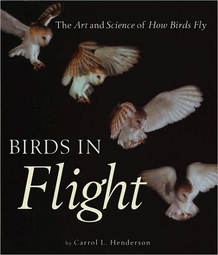Reviewed by Grant McCreary on January 28th, 2009.
Flight. It is undeniably one of the primary characteristics that draw people to birds. If you’re a birdwatcher, I think it is safe to say that you are keenly aware of bird flight, especially as it pertains to identification. But have you ever wondered why certain birds fly the way they do? Or why there are so many different wing and tail shapes? Or an even more basic question: how are birds able to fly at all?
To answer these questions, the author starts with an explanation of the aerodynamic principles involved. He describes how it is possible for a bird (or an airplane, for that matter) to break the chains of gravity and fly. But in order for a bird to take advantage of these principles, certain adaptations are required. Henderson goes on to explain how a bird’s feathers, bones, wings, and tail all work together to allow flight.
 I found the chapter on tails especially interesting. It highlights several unusual tail shapes, such as streamers, forked, and wedge-shaped, and describes the advantages of each. Birders notice such things as it applies to identification, but we don’t often stop to wonder why there are such differences (I may be speaking too broadly there, but I will admit that I do not). This information brings to mind many interesting questions. For instance, birders know that the primary field mark for distinguishing ravens and crows is the tail – ravens are wedge-shaped, and crows square-tipped. Why the difference? According to this book, wedge-shaped tails confer greater maneuverability. So why would ravens need to be more maneuverable than crows? I haven’t been able to come up with a good reason.
I found the chapter on tails especially interesting. It highlights several unusual tail shapes, such as streamers, forked, and wedge-shaped, and describes the advantages of each. Birders notice such things as it applies to identification, but we don’t often stop to wonder why there are such differences (I may be speaking too broadly there, but I will admit that I do not). This information brings to mind many interesting questions. For instance, birders know that the primary field mark for distinguishing ravens and crows is the tail – ravens are wedge-shaped, and crows square-tipped. Why the difference? According to this book, wedge-shaped tails confer greater maneuverability. So why would ravens need to be more maneuverable than crows? I haven’t been able to come up with a good reason.
Next, the stages of flight are analyzed, starting with taking off, continuing to the different types of flight, and ending with the landing. It is somewhat surprising to see how many different ways birds take off and land.
Numerous photographs and diagrams illustrate the concepts described by the text. Overall, the photographs of Birds in Flight are quite good. Some are outstanding, but others are not necessarily technically perfect in terms of sharpness, focus, and the like (unlike On Feathered Wings [review], for example). But that’s not a problem here. It is more important that the photos are instructive, and well illustrate the concepts. And in that regard, they excel.
Additionally, a third of the book consists of an annotated photo gallery devoted to displaying the art of flight. As with the rest of the photos, some of these are incredible. However, others are so blurry that it’s hard to tell what species is shown! But this is intentional. The author is trying to get the reader to look beyond the technical merits of a bird photograph, and even beyond species identification, to see the underlying beauty of flight. And it is undeniably beautiful. Some of these pictures, especially the more unconventional ones, look more like paintings than photographs.

The only real problem with the photos is that not all of them are captioned with the species name. A few only identify the bird to the family level (ie “goose”). Granted, identification is not the point of the book, but I would imagine that most readers would appreciate knowing exactly what they’re looking at. We are birders after all!
Recommendation
Birds in Flight takes a very complicated subject, which includes elements of anatomy, ecology, and physics, and presents it in a way that non-professionals can understand. This is the best general treatment of avian flight that I have seen. Moreover, there is an abundance of interesting information, such as the aforementioned explanation of tail shapes, and a possible reason why Turkey Vultures fly with their wings in a dihedral position and rock back and forth. Anyone who wants to learn more about this fundamental aspect of birds’ lives would be well advised to start here.
Disclosure: I get a small commission for purchases made through links in this post.






This book has good pictures and descriptions overall, and it’s obvious the author is enthralled with his subject.
That said, the mathematical explanation of wing-loading found on page 67 is confused and confusing. The introductory sentences are correct and understandable: that wing-loading is the ratio of the bird’s weight to the wing surface area, and is calculated by dividing the weight of a bird by the total surface area of both wings. Then *immediately below that* is supposedly an illustrative equation that is *upside down*! And to its right are pictures of birds supposedly illustrating differences in wing-loading, but the units of the ratios are upside-down from what they should be, which probably indicates that the wing-loading values stated are actually inverses of what they should be. The description of the effect of differences in wing-loading seems to be correct, but the arithmetic is all wrong.
Nice catch!